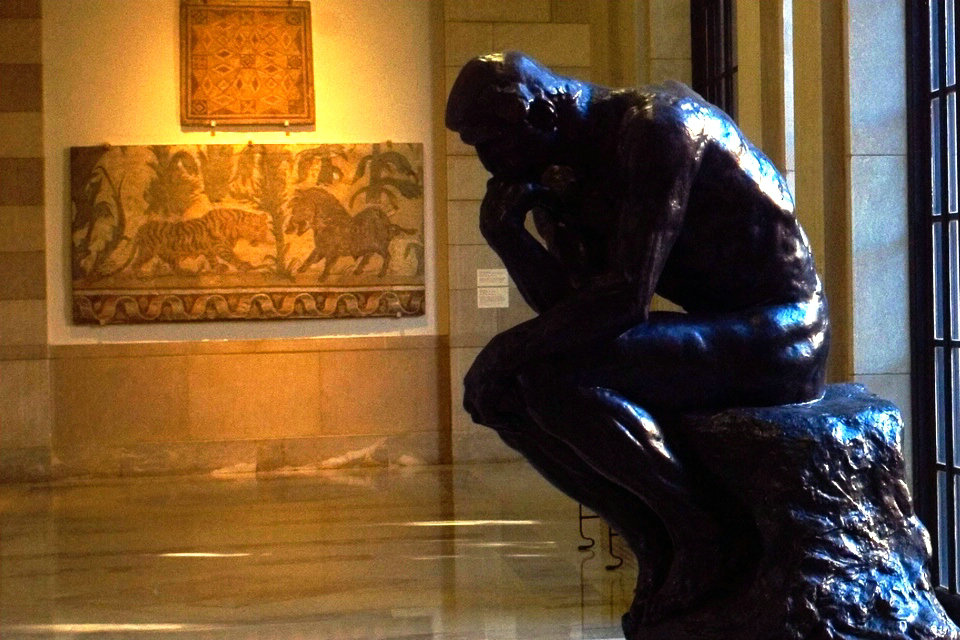Antioch Mosaics, Baltimore Museum of Art


The BMA exhibits a collection of Antioch mosaics, the result of its participation in excavations of this ancient city, known today as Antakya in southeastern Turkey, near the border of Syria.
With the support of BMA Trustee Robert Garrett, the Baltimore Museum of Art joined the Musées Nationaux de France, Worcester Art Museum, and Princeton University during the excavations of 1932 to 1939, discovering 300 mosaic pavements in and around the lost city. The BMA received some of the mosaics from the excavation, totaling 34 pavements, 28 of which are on display in the museum’s sunlit atrium court.
Discovered in the affluent suburb of Daphne and the nearby port city of Seleucia Pieria, the mosaics date from the days of the emperor Hadrian in the 2nd century A.D. to the Christian empire of Justinian in the 6th century, bridging the Classical world and the early Middle Ages. The mosaics illustrate how the classical art of Greece and Rome evolved into the art of the early Christian era, and tell the story of how people lived in this ancient city prior to its destruction by catastrophic earthquakes in 526 and 528 A.D. The mosaics are notable for their grand scale and elaborately patterned borders, and the brilliance of their decorative and naturalistic effects.
The Antioch Mosaics illustrate how the classical art of Greece and Rome evolved into the art of the early Christian era and tell the story of how people lived in this ancient city prior to its destruction by catastrophic earthquakes in 526 and 528 A.D.
They are notable for their:
Grand scale
Elaborately patterned borders
Decorative and naturalistic effects
Discovery of the Mosaics – 1932 to 1939
With the support of BMA Trustee Robert Garrett, the BMA joined the Musées Nationaux de France, Worcester Art Museum, and Princeton University during the 1930s excavations of Antioch. Three hundred mosaic pavements were discovered in the affluent suburb of Daphne and the nearby port city of Seleucia Pieria.
Today Antioch is known as Antakya, and is located in southeastern Turkey, near the border of Syria.
There are 24 pavements from the Antioch Mosaics on display in the Museum’s sunlit Antioch Court.
Baltimore Museum of Art
The Baltimore Museum of Art (BMA), located in Baltimore, Maryland, United States, is an art museum that was founded in 1914. While founded with a single painting, today the BMA has over 95,000 works of art—including the largest public holding of works by Henri Matisse. Collection highlights include a selection of American and European painting, sculpture, and decorative arts; works by contemporary artists; significant artworks from China; Antioch mosaics, and a collection of art from Africa. The BMA’s galleries showcase examples from one of the nation’s collections of prints, drawings, and photographs and textiles from around the world.The museum also has a landscaped 2.7-acre sculpture garden. The museum encompasses a 210,000 sq. ft. building that was originally built in 1929, in the “Roman Temple” architectural style, under the design of famous American architect John Russell Pope. The museum is located between Charles Village, to the east, Remington, to the south, Hampden, to the west; and south of the Roland Park neighborhoods, immediately adjacent to the Homewood campus of Johns Hopkins University, though the museum is an independent institution that is not affiliated with the university.
The highlight of the museum is the Cone Collection, brought together by Baltimore sisters Dr. Claribel (1864–1929) and Etta Cone (1870–1949). Accomplished collectors, the sisters amassed a wealth of works by artists including Matisse, Picasso, Cézanne, Manet, Degas, Giambattista Pittoni, Gauguin, van Gogh, and Renoir, nearly all of which were donated to the museum. The museum is also the permanent home of the George A. Lucas collection of 18,000 works of French mid-nineteenth-century art, which has been acclaimed by the museum as a cultural “treasure” and “among the greatest single holdings of French art in the country.”
The BMA is currently led by Director Christopher Bedford, who was appointed in May 2016, after a year-long search. Prior to joining the BMA, Bedford led the Rose Art Museum at Brandeis University in Massachusetts for four years. He helped the Rose Art Museum out of international controversy in 2009 when, during the economic recession, the museum proposed selling off their top-notch art collection to help with its struggling finances.
The Baltimore Museum of Art is home to an internationally renowned collection of 19th-century, modern, and contemporary art. Founded in 1914 with a single painting, the BMA today has 95,000 works of art—including the largest holding of works by Henri Matisse in the world.
The Museum has a long tradition of collecting the art of the day, beginning with the Cone Sisters, whose acquisitions from living artists lead the Museum’s commitment to contemporary art.
Since October 2006, the Baltimore Museum of Art and the Walters Art Museum (formerly Walters Art Gallery), have offered free general admission year-round as a result of grants given by Baltimore City, Baltimore County, and several foundations.